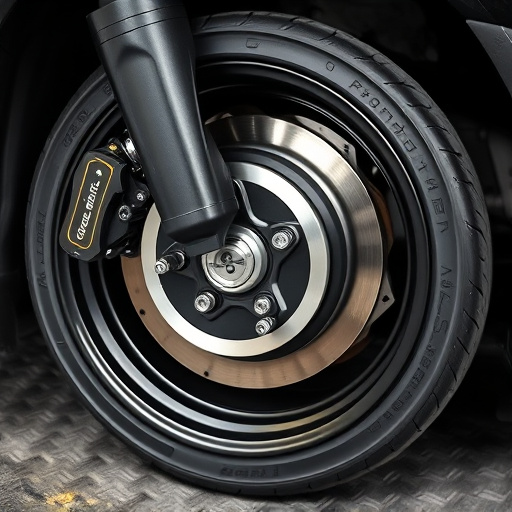Anti Roll Bars: Boosting Vehicle Stability for Safer Cornering
An anti roll bar (ARB), also known as a stability bar, is a critical component of a vehicle's s…….
Welcome to an in-depth exploration of the critical automotive component, the anti-roll bar (ARB). This article aims to guide readers through the intricacies of ARBs, from their foundational mechanics to their profound global impact and future potential. As we delve into this topic, you’ll gain insights into how these structural elements contribute to vehicle safety, handling, and performance worldwide.
An anti-roll bar is a mechanical device designed to minimize body roll in vehicles during cornering or unpredictable road conditions. It is a pivotal component of a vehicle’s suspension system, typically composed of:
The concept of ARBs traces back to the early 20th century when automobile manufacturers sought ways to enhance vehicle stability. Early forms included simple links of chain or cable connecting opposing wheels. However, modern anti-roll bars, as we know them today, emerged in the late 1960s with advancements in material science and engineering.
ARBs play a pivotal role in:
The impact of anti-roll bars is not limited to a single region; they are universally recognized as essential components in modern vehicle design. Global trends reveal a growing demand for advanced suspension systems, driving innovation in ARB technology:
| Region | Trend | Impact |
|---|---|---|
| North America | Increasing adoption in light vehicles | Enhances safety and fuel efficiency |
| Europe | Stricter regulatory standards | Lead to sophisticated active ARB systems |
| Asia-Pacific | Focus on performance tuning | Customized ARBs for sportier handling |
| Emerging Markets | Cost-effective solutions | Local manufacturers develop affordable ARBs |
Different regions have unique challenges that influence anti-roll bar design:
The global anti-roll bar market is a dynamic sector, driven by:
Major automotive manufacturers invest heavily in ARB research and development to:
Recent advancements in materials science have revolutionized anti-roll bars:
A significant technological trend is the integration of anti-roll bars into active suspension systems:
Key policies and regulations governing anti-roll bars include:
Regulatory bodies influence ARB development through:
Some challenges faced by anti-roll bars include:
Proposed solutions include:
Challenge: Achieve exceptional handling and stability in a high-performance sports car.
Solution: Porsche engineered an adjustable active anti-roll bar system, allowing drivers to select between comfortable cruising and agile cornering modes. This customizable ARB enhances both daily driving and track performance.
Outcome: Improved driver satisfaction and enhanced safety ratings, solidifying the 911’s reputation as a handling icon.
Goal: Create an SUV capable of tackling rugged terrain while offering on-road comfort.
Approach: The Jeep Wrangler features a robust, fully independent suspension with adjustable ARBs. This design allows for smooth on-road travel and exceptional off-road performance, catering to outdoor enthusiasts.
Result: Increased market share in the compact SUV segment, attracting buyers seeking versatility and adventure.
Objective: Design an electric vehicle with advanced safety features while minimizing weight for better range.
Implementation: Nissan incorporated lightweight aluminum ARBs into the Nissan Leaf’s suspension. This reduction in weight contributed to improved fuel efficiency without compromising safety.
Impact: Enhanced the Leaf’s overall appeal, showcasing the potential of green technology and lightweight materials.
The future of anti-roll bars looks promising with these emerging trends:
In conclusion, anti-roll bars have evolved from simple mechanical devices to sophisticated suspension components, playing a pivotal role in modern vehicles. Their global impact is evident across diverse regions, with manufacturers constantly pushing the boundaries of design and technology. As we look ahead, ARBs will continue to be integral to vehicle safety, handling, and performance, shaping the future of automotive engineering.
Q: What is the primary function of an anti-roll bar?
A: An anti-roll bar’s main task is to minimize body roll in vehicles during cornering or uneven road conditions, enhancing stability and driver control.
Q: How do ARBs differ from traditional suspension systems?
A: Unlike conventional springs, ARBs are designed specifically to resist roll motion, providing active control for improved handling and safety.
Q: Can anti-roll bars be customized for performance tuning?
A: Absolutely! Many high-performance vehicles offer adjustable or customizable ARBs, allowing drivers to fine-tune their handling characteristics.
Q: What are the environmental benefits of advanced ARB materials?
A: Lighter materials like aluminum and composite fibers reduce vehicle weight, leading to lower fuel consumption and decreased carbon emissions.
Q: How do global safety regulations impact anti-roll bar design?
A: Stricter crash tests and safety standards have driven advancements in ARB technology, making them safer and more effective in protecting occupants.

Anti roll bars (ARBs) are essential suspension components that optimize vehicle handling, stability,…….